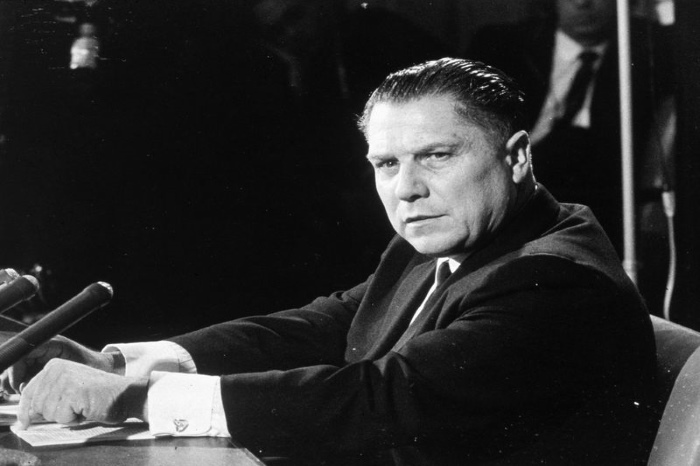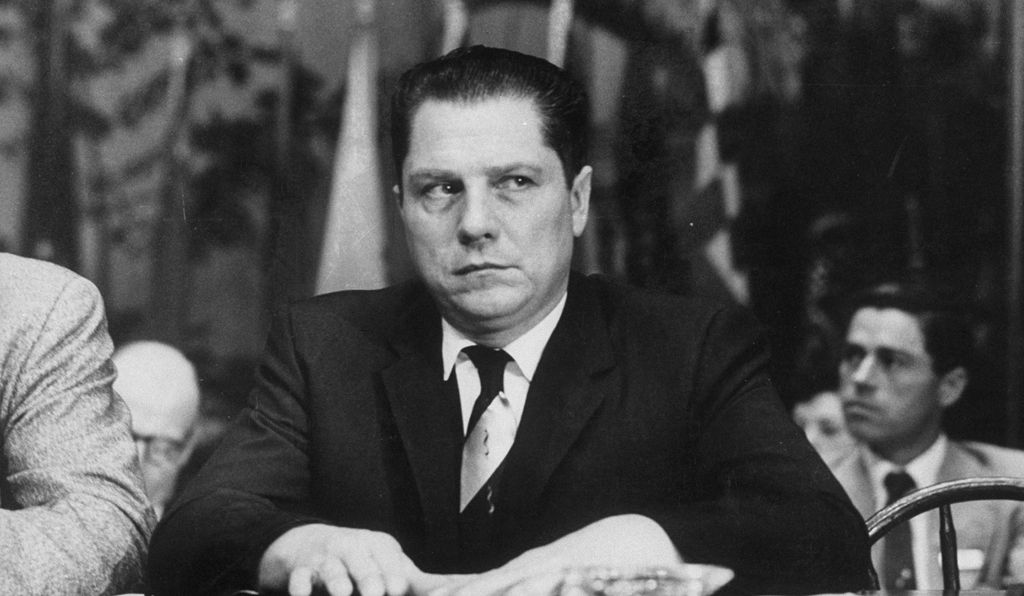Many have suggested Frank Sheeran’s claims about the murder of Jimmy Hoffa are mere fantasy; the historical context of Scorsese’s epic is more nuanced

Martin Scorsese’s The Irishman provides a decades-spanning look at one man’s relationship to organized crime, organized labor, and the truth—however slippery that concept may be. That man, Frank Sheeran, played by Robert De Niro, was a union official and mob associate whose story intersects with labor organizer Jimmy Hoffa, the Mafia, and the Kennedys. The film, Scorsese’s first to stream exclusively on Netflix, is adapted from the 2004 Sheeran biography I Heard You Paint Houses by writer Charles Brandt, in which Sheeran claims that he killed Hoffa, amongst other figures. Hoffa’s sudden disappearance in 1975 still looms large as one of America’s longest-standing unsolved mysteries.
Sheeran’s stories are seductive—he was friends with Hoffa (Al Pacino), and he was an associate of Russell Bufalino (Joe Pesci), a mob figure who indeed had ties to both Hoffa and other high-level mafia families. And while many Hoffa scholars think Sheeran’s claims are bogus, and that Scorsese—and Robert De Niro, who has wanted to adapt the book for years—got the story wrong, the film’s portrait of how organized crime became interwoven with the labor movement and the highest levels of government in the 20th century carries many elements of truth.
As a guide to that era, here’s a primer that can either provide you with some key background information before sitting down to watch The Irishman or to fill in the gaps after viewing. The movie, which leaves theaters next week and will be available on Netflix starting Wednesday, November 27, runs more than three hours, so you have a lot of historical ground to cover.
Who was Jimmy Hoffa and was he really the most famous man in America?
James Hoffa, mostly known by the media as Jimmy, was a labor organizer even in his early career—at 14, he dropped out of school to work full time, and as a teenager he organized fellow grocery store workers to challenge unfair treatment by managers and to advocate for higher wages. He joined the International Brotherhood of the Teamsters in 1932 when he was still a teen, and by 1957 was elected president of the union, which at that point represented nearly one million truck drivers and warehouse workers. At one point in The Irishman, a voiceover from De Niro’s Sheeran asserts that Hoffa, in the 1950s and ’60s, was more famous than Elvis or the Beatles. That’s not an exaggeration—in a time when nearly one-third of American workers belonged to a union, Hoffa was the movement’s most famous face and de facto voice. On July 30, 1975, Hoffa set out for a lunch meeting at a local restaurant, and when he hadn’t returned home by the next morning, his wife Josephine called police. No trace of Hoffa was seen after that day, and he was declared legally dead in 1982. While some thought he was murdered by mafia associates, others thought it might be rivals within the Teamsters, and another line of inquiry attempted to discover whether or not Hoffa, afraid for his life, vanished of his own accord.

What did the Teamsters have to do with the Mafia?
In the mid-20th century, the Teamsters’ pension fund grew in size as membershipswelled. Many mafia families used this fund as a piggy bank, taking out off-the-books loans they’d use to fund the construction of casinos in Las Vegas (the mechanics of this story are detailed in Casino, another Scorsese film). “The problem with the loans to the Mob-controlled projects”, explained the National Museum of Organized Crime & Law Enforcement in a 2015 blog post, “was that many of them were not repaid promptly (or at all), and the corrupting influence facilitated ‘the skim’—the tax-free diversion of casino cash, delivered in suitcases to Midwestern mobsters.” Some of this cash made its way back to Hoffa and other union officials. At lower levels, mob enforcers would ensure unions won prime building, trucking, and transport contracts, keeping the flow of money steady. They would also pitch-in to help fix elections, either within the union itself or in city governments, ensuring key positions were held by union-friendly (and mob-friendly) candidates.
Who, then, was Frank Sheeran?
Many historians of the FBI, labor unions, and organized crime cast aspersions on Frank Sheeran’s stories that he killed Hoffa, or that he killed infamous “Crazy Joe Gallo” in Manhattan’s Little Italy in 1972. Writer and mafia historian Bill Tonelli, writing in Slate, exhaustively argues that Sheeran’s claims are mere fantasy: “Not a single person I spoke with who knew Sheeran from Philly—and I interviewed cops and criminals and prosecutors and reporters—could remember even a suspicion that he had ever killed anyone.”
But some of what Frank Sheeran says to Brandt in I Heard You Paint Houses is true—he was a close associate of mafia boss Russell Bufalino, and through Bufalino he did come to be well-acquainted with Jimmy Hoffa.
An Irish-Catholic WWII veteran, Sheeran, a truck driver by trade, began doing small jobs for Bufalino and the even higher-up Angelo Bruno (Harvey Keitel). As a non-Italian, he wasn’t eligible for full-fledged membership in the Cosa Nostra, but he was considered a trusted associate and friend by Bufalino. In I Heard You Paint Houses, Sheeran, who died in 2003, alleges that through Bufalino he became Hoffa’s right-hand man, tasked with protecting him on trips and even performing assassinations as necessary.
What role did Bufalino play in the Mafia hierarchy? Why was he important to the Hoffa story?
Born in Sicily in 1902, Russell Bufalino immigrated to the United States as a child. His family settled in Buffalo, New York, and after moving as a young adult to Northeastern Pennsylvania, Bufalino, by the mid-1960s, was the country’s most important mafia figure not based in a major city. His crew controlled Rust Belt communities like Wilkes-Barre and Scranton, Pennsylvania, and desolate stretches of highway that were useful to the mob because of both coal mining and long-haul trucking. Bufalino’s cousin, Bill (Ray Romano), meanwhile was Jimmy Hoffa’s personal attorney.
While never as notorious or prominent in the news as peers like Carlo Gambino or Joe Bonano, Bufalino was nonetheless a central figure in mid-century organized crime, and in the early 1970s was reportedly the interim head of the notorious Genovese family. As early as 1964, Bufalino was on law enforcement’s radar—a Senate subcommittee on organized crime called him “one of the most ruthless and powerful leaders of the Mafia in the United States.” In 1978 he was sentenced to four years in federal prison on an extortion charge, and was later sent back for an additional decade after a hitman he hired became a government informant. By all accounts, Bufalino and Sheeran remained close until the former’s release from prison in 1989, with Sheeran, convicted in the late 1970s of labor racketeering, continuing to act as Bufalino’s bodyguard and caretaker behind bars.
How did the Kennedys get involved in this story?
John F. Kennedy’s relationship with the mafia is probably second only to his relationship with Marilyn Monroe in terms of public fascination. While little direct evidence connects Kennedy patriarch Joseph P. Kennedy, Sr. to the bootlegging industry of the Prohibition age, he was a shrewd Wall Street investor and, later, Hollywood power player—he made several films in the 1920s with star Gloria Swanson (who also happened to be his mistress). At various points Kennedy served as the chairman of the Securities and Exchange Commission and the U.S. Ambassador to the United Kingdom, and he used this political capital to help the careers of his sons. In The Dark Side of Camelot, journalist Seymour Hersh alleges that Kennedy also leveraged his influence with the Chicago mafia to secure JFK’s victory over Richard Nixon in the presidential election of 1960. Scorsese’s film presents these connections as fact, even bringing up the persistent—but still unsubstantiated—suggestion that JFK’s assassination was a mafia hit.